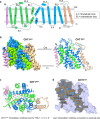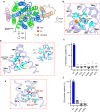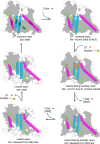Structural mechanisms of human sodium-coupled high-affinity choline transporter CHT1
- PMID: 39587078
- PMCID: PMC11589582
- DOI: 10.1038/s41421-024-00731-7
Structural mechanisms of human sodium-coupled high-affinity choline transporter CHT1
Abstract
Mammalian sodium-coupled high-affinity choline transporter CHT1 uptakes choline in cholinergic neurons for acetylcholine synthesis and plays a critical role in cholinergic neurotransmission. Here, we present the high-resolution cryo-EM structures of human CHT1 in apo, substrate- and ion-bound, hemicholinium-3-inhibited, and ML352-inhibited states. These structures represent three distinct conformational states, elucidating the structural basis of the CHT1-mediated choline uptake mechanism. Three ion-binding sites, two for Na+ and one for Cl-, are unambiguously defined in the structures, demonstrating that both ions are indispensable cofactors for high-affinity choline-binding and are likely transported together with the substrate in a 2:1:1 stoichiometry. The two inhibitor-bound CHT1 structures reveal two distinct inhibitory mechanisms and provide a potential structural platform for designing therapeutic drugs to manipulate cholinergic neuron activity. Combined with the functional analysis, this study provides a comprehensive view of the structural mechanisms underlying substrate specificity, substrate/ion co-transport, and drug inhibition of a physiologically important symporter.
© 2024. The Author(s).
Conflict of interest statement
Conflict of interest: The authors declare no competing interests.
Figures







Similar articles
-
Ion coupling and inhibitory mechanisms of the human presynaptic high-affinity choline transporter CHT1.Structure. 2025 Feb 6;33(2):321-329.e5. doi: 10.1016/j.str.2024.11.009. Epub 2024 Dec 9. Structure. 2025. PMID: 39657660
-
Competitive inhibition of the high-affinity choline transporter by tetrahydropyrimidine anthelmintics.Eur J Pharmacol. 2021 May 5;898:173986. doi: 10.1016/j.ejphar.2021.173986. Epub 2021 Feb 26. Eur J Pharmacol. 2021. PMID: 33640406
-
Transport mechanism of presynaptic high-affinity choline uptake by CHT1.Nat Struct Mol Biol. 2024 Apr;31(4):701-709. doi: 10.1038/s41594-024-01259-w. Epub 2024 Apr 8. Nat Struct Mol Biol. 2024. PMID: 38589607
-
High-affinity choline transporter.Neurochem Res. 2003 Apr;28(3-4):483-8. doi: 10.1023/a:1022809003997. Neurochem Res. 2003. PMID: 12675135 Review.
-
Molecular properties of the high-affinity choline transporter CHT1.J Biochem. 2014 Oct;156(4):181-94. doi: 10.1093/jb/mvu047. Epub 2014 Jul 29. J Biochem. 2014. PMID: 25073461 Review.
References
Grants and funding
- I-1578/Welch Foundation
- RP170644/Cancer Prevention and Research Institute of Texas (Cancer Prevention Research Institute of Texas)
- RP170644/Cancer Prevention and Research Institute of Texas (Cancer Prevention Research Institute of Texas)
- 32371300/National Natural Science Foundation of China (National Science Foundation of China)
LinkOut - more resources
Full Text Sources

